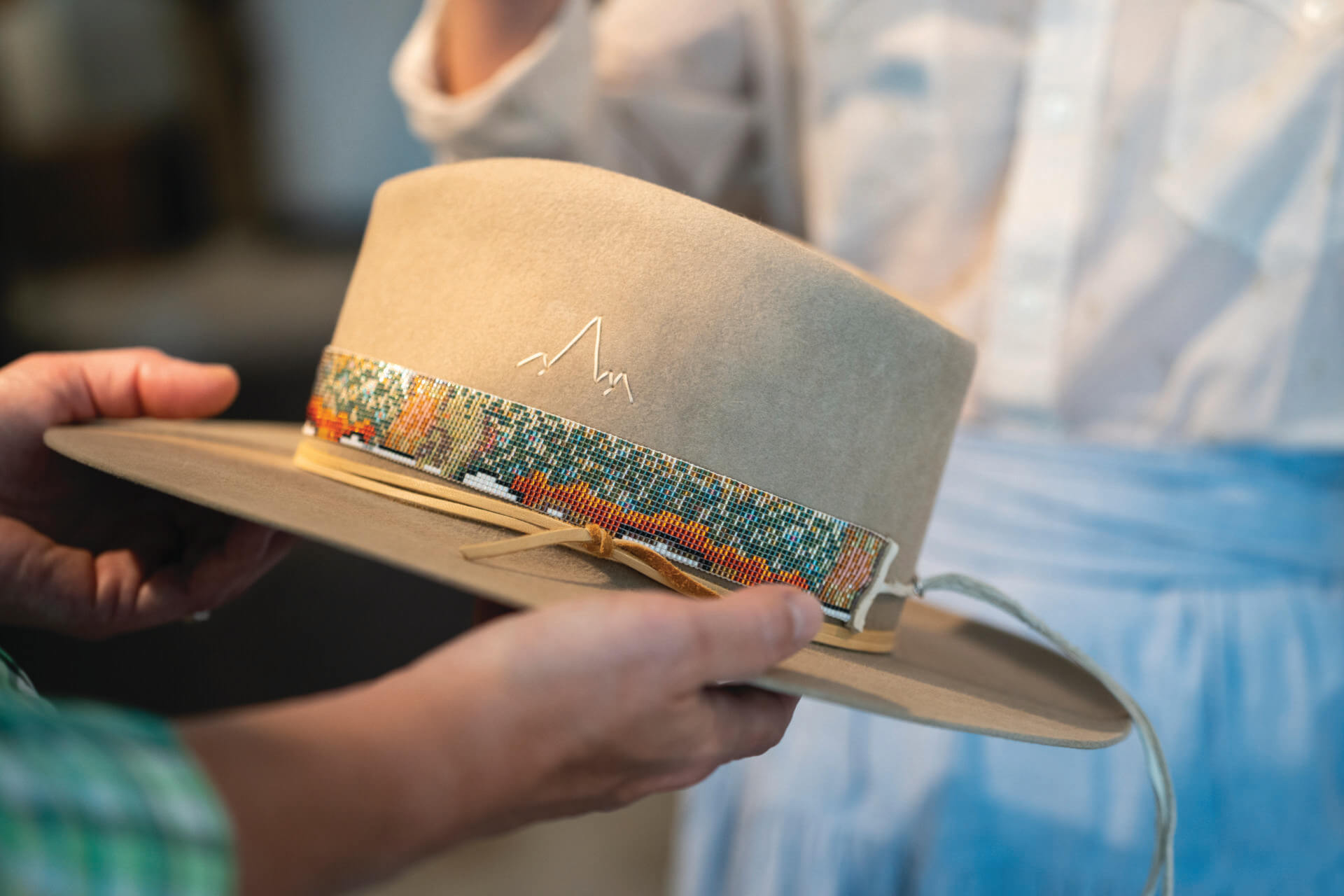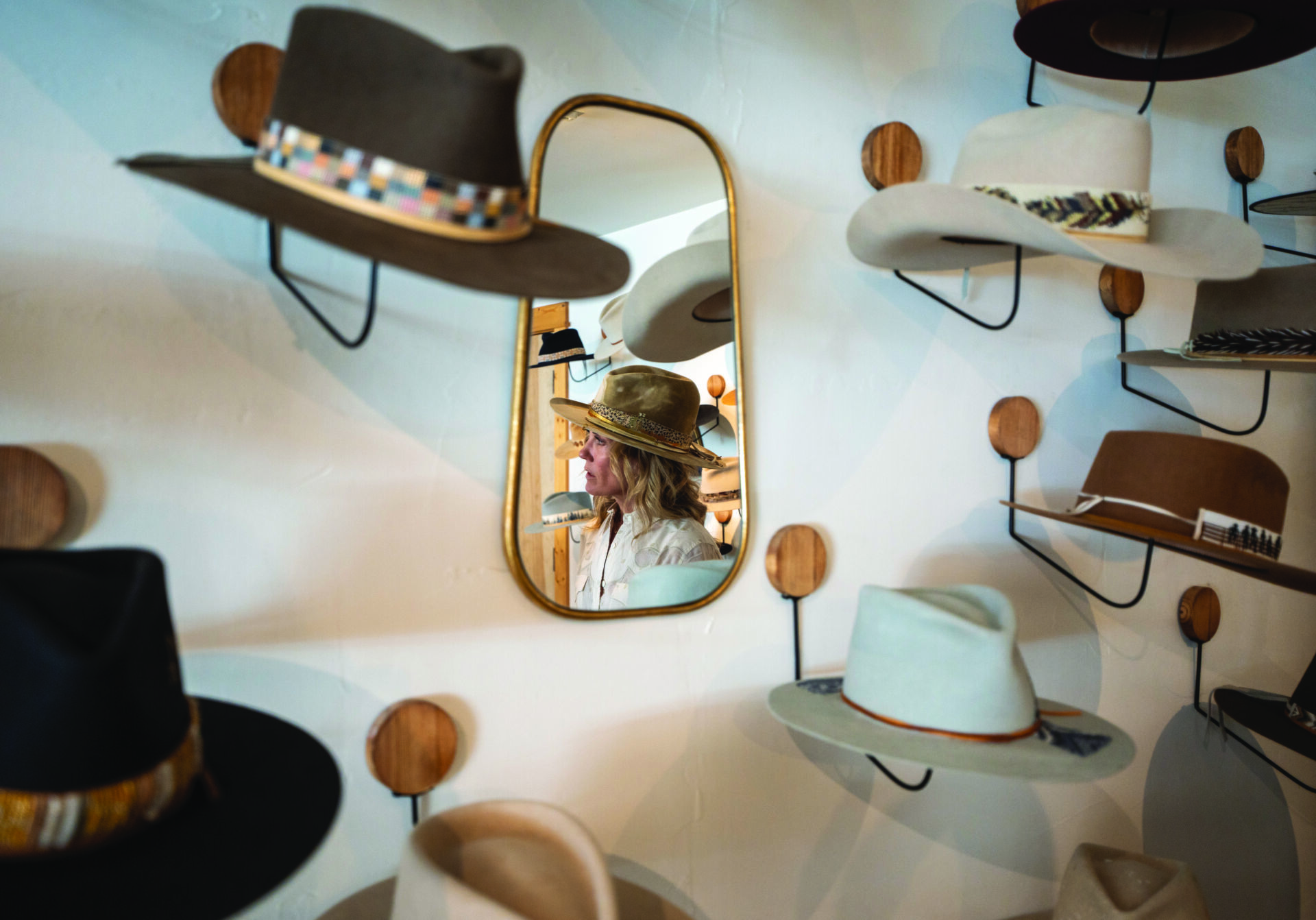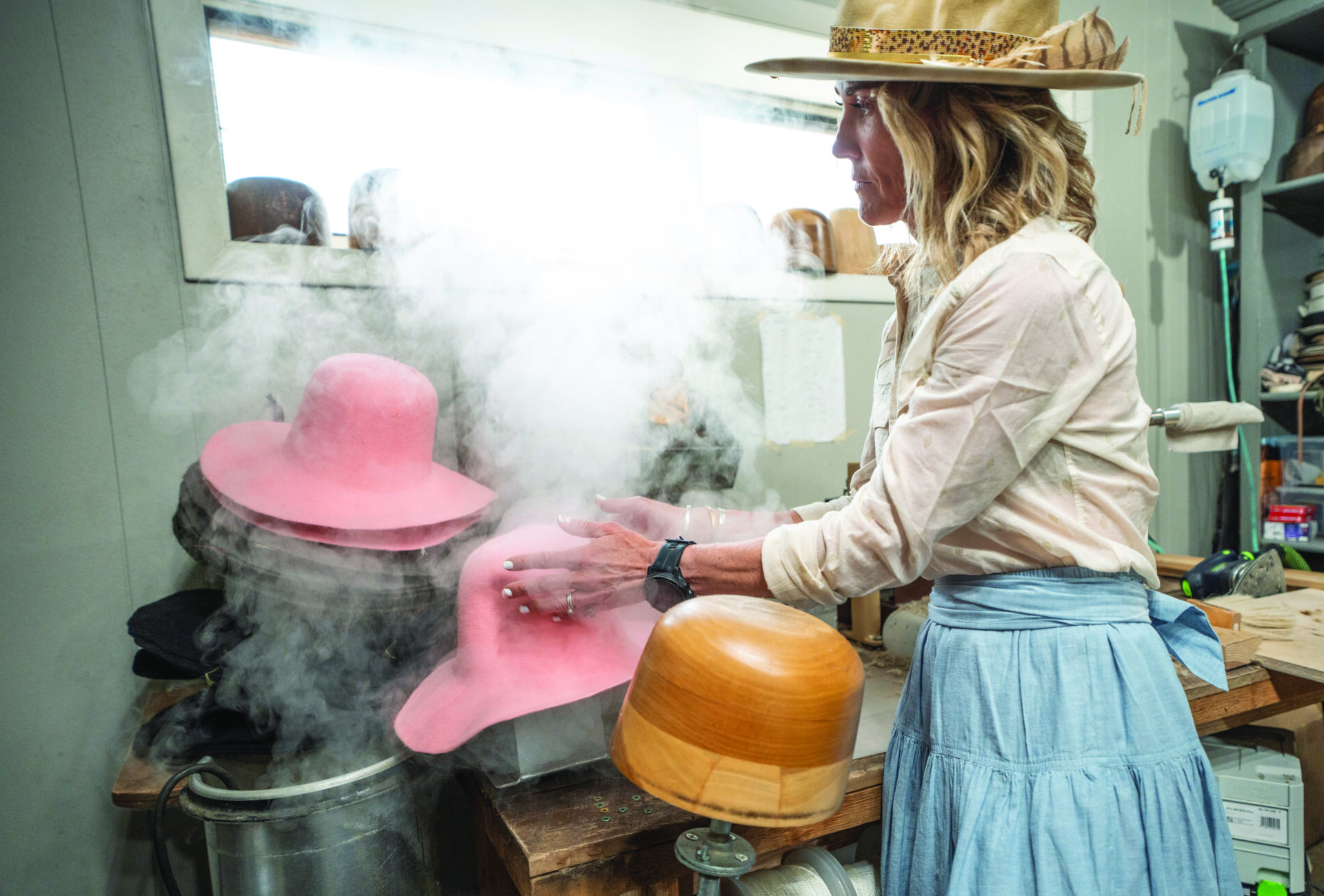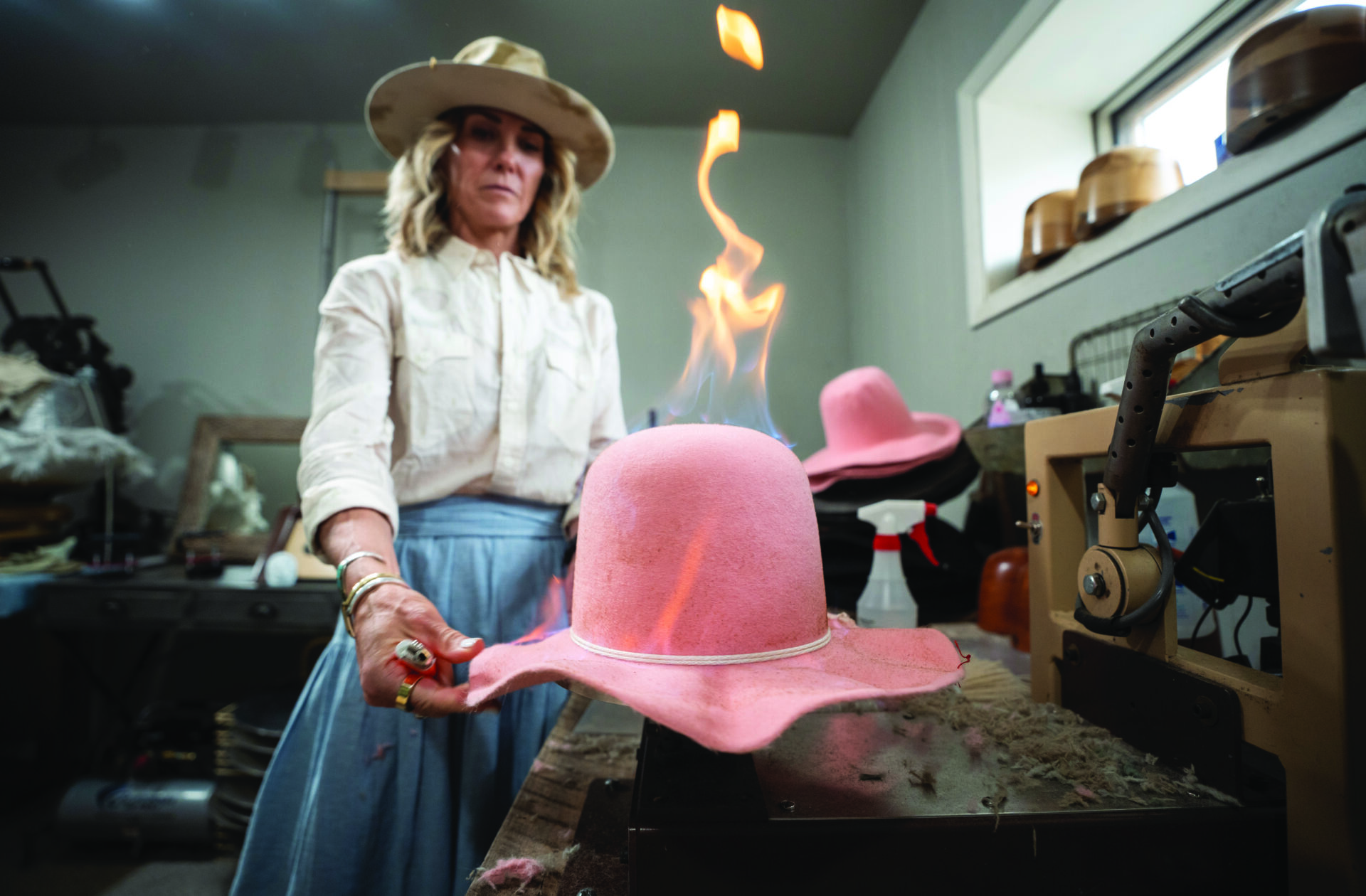Read The
Current Issue
Wearable Art
A local woman-owned hattery makes contemporary Western hats that look good in Jackson Hole and beyond.
// By Dina Mishev // photography By KATHRYN ZIESIG

I’ve got a small head, at least in the literal sense. So says Sarah Kjorstad, the founder of and hat-maker at the custom hattery JW Bennett. After more than 25 years of living in Jackson Hole and fruitlessly searching for a Western hat that didn’t make me feel like I was playing dress-up as a cowgirl—I’m more comfortable on mountain summits than in a saddle—and that I did look okay in, I’ve put myself in Kjorstad’s skilled hands to find the perfect hat. “There is a hat for everyone,” she says. “But finding it is a bit of science and a lot of emotion. It needs to fit your face, style, and environment. The perfect hat will be a feeling when you put it on.”
Because my head is among the smallest of the ready-to-wear sizes Kjorstad stocks in her store near Jackson’s Town Square, the feeling I get from the first several hats I put on is of bigness. (Kjorstad can custom-make any size and shape, but I want a hat to wear to a party tonight, so my selection is limited, although “limited” still means at least a dozen hats in my tiny size from which to choose.)
Seeing someone find their perfect hat gives Kjorstad a feeling, too. After her son, Landon, was settled into elementary school, Kjorstad, who previously had a successful career as a physical therapist, “wanted to do something that was creative and that spoke to my soul and that was a legitimate business, not some side gig,” she says. She started doing some beading, but that wasn’t cutting it. “I wanted something bigger,” she says. Having grown up on a ranch in far eastern Wyoming, in Niobrara County, that her mom’s grandparents had homesteaded, Kjorstad knew cowboys and cowgirls—and their hats. Living in Jackson Hole, she knew it wasn’t just cowboys and cowgirls who wanted Western hats. “I thought that contemporary Western hats—hats that were at home in Jackson Hole, but not so Western they looked costume-y in a city—were something that people would appreciate.” That Christmas, then nine-year-old Landon and her husband gave her a hand-written coupon good for “a hat class to start your own business.”
The name of Kjorstad’s hattery, JW Bennett, honors her family and its ranching legacy. “J” and “W” are her mom’s and dad’s initials (Jimmy and Jackie Williams) and their cattle brand is called “upside down J-W.” Bennett is the maiden name of Kjorstad’s grandmother and her dad’s middle name.

In 2017, Kjorstad traveled to Covington, Tennessee, to learn the art and craft of making hats from Mike Moore, founder of Buckaroo Hatters. “They showed me just enough to be dangerous,” she says. She returned home, rustled up the necessary equipment (with some luck and Moore’s help; much hat-making equipment is antique because the demand for custom hats has been on the decline for the last century), and started shaping hats. “Shaping a hat is like molding clay,” Kjorstad says. “It was not going well for me and was frustrating and scary.” At one point, she was so frustrated she took the hat she was working on—whose shape she didn’t like—put it on her head, and “squashed it.” And that made it a shape she actually liked. “But it was specific to my head,” she says. “It wasn’t something I could stock.” (Called the “rough rider,” she does custom make this hat for clients.) Kjorstad went back to Covington to do a deep dive in shaping. “I wanted to learn how to do the classic shapes and do them well,” she says. “Once I got the classics down, I figured I could riff on those and be more confident in and trust my own shapes.”
Before I can pick the shape of my hat though, I need to figure out the correct size. Kjorstad says the fit is right when I feel the hat sitting on my forehead but it’s not constricting. The next decision is what weight of hat I want—dress or 100X. Both are made from high-quality felt Kjorstad sources mostly from Tennessee. “The dress hats can need reshaping from time to time due to their softer nature,” she says. It’s easy for a professional to reshape a felt hat, but I like the idea of low-maintenance. Kjorstad says the shape of a 100X hat is indestructible, so I go with that weight. Now it’s time to select the shape and color. Having previously purchased a handful of hats whose shapes I did not like on me, I prioritize shape—a teardrop crown—and then color—Sahara, a warm tan.

“There is a hat for everyone. But finding it is a bit of science and a lot of emotion. It needs to fit your face, your style, and environment. The perfect hat will be a feeling when you put it on.”
—Sarah Kjorstad
All of these decisions have taken almost an hour, and my brain is a little tired. “But now the fun starts,” Kjorstad says. I have a hat; now I need to style and accessorize it. Do I want my initials branded onto it? Do I want to keep the brim flat, or give it a little shape? Every JW Bennett hat comes with a hand-sewn silhouette of the Tetons on the side of its crown; I can add additional flair via a hand-loomed bead or feather band, facsimiles of flies, and hat jewelry.
Because Kjorstad says the branding can happen at any point in the future, I skip it for now. Because the felt can be reshaped an almost infinite number of times, I decide to play with the brim a bit, adding a small lip along the front of one side. “If you decide you don’t like it, we can try something different,” Kjorstad says as she steams the brim to ready it to take a new shape.

While I like the feathered bands for the fact that all of the feathers in them come from Kjorstad family hunting trips, I ultimately decide on a Sunset beaded band—“Its colors are inspired by the mountain skies,” Kjorstad says—and, even though I’m no more a fly-fisherwoman than I am a cowgirl, a version of a Jock Scott salmon fly. It’s green, my favorite color. (Kjorstad makes sure to point out that she knows we don’t have salmon to fish for in Wyoming. “The fly is an ode to the outdoors person and makes a bigger statement on the hat!” she says)
With the brim reshaped, the Sunset band snugged at the base of the hat, and the green fly pinned onto the crown, I nervously put my hat on. What if I don’t feel anything? Sensing my trepidation, Kjorstad says, “I can already tell—you don’t have anything to worry about.” She’s right. It’s the same feeling I get when I meet a new acquaintance that I think might grow into a good friend. Felt hats from $645; 55 N. Glenwood St., Suite E, Jackson; 307/201-5669, jwbennett.com JH




